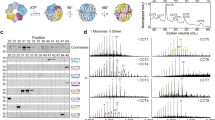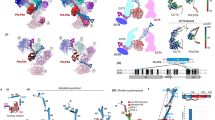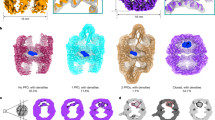Abstract
Folding within the crowded cellular milieu often requires assistance from molecular chaperones that prevent inappropriate interactions leading to aggregation and toxicity. The contribution of individual chaperones to folding the proteome remains elusive. Here we demonstrate that the eukaryotic chaperonin TRiC/CCT (TCP1-ring complex or chaperonin containing TCP1) has broad binding specificity in vitro, similar to the prokaryotic chaperonin GroEL. However, in vivo, TRiC substrate selection is not based solely on intrinsic determinants; instead, specificity is dictated by factors present during protein biogenesis. The identification of cellular substrates revealed that TRiC interacts with folding intermediates of a subset of structurally and functionally diverse polypeptides. Bioinformatics analysis revealed an enrichment in multidomain proteins and regions of β-strand propensity that are predicted to be slow folding and aggregation prone. Thus, TRiC may have evolved to protect complex protein topologies within its central cavity during biosynthesis and folding.
This is a preview of subscription content, access via your institution
Access options
Subscribe to this journal
Receive 12 print issues and online access
$209.00 per year
only $17.42 per issue
Buy this article
- Purchase on SpringerLink
- Instant access to full article PDF
Prices may be subject to local taxes which are calculated during checkout





Similar content being viewed by others
References
Frydman, J. Folding of newly translated proteins in vivo: the role of molecular chaperones. Annu. Rev. Biochem. 70, 603–647 (2001).
Young, J.C., Agashe, V.R., Siegers, K. & Hartl, F.U. Pathways of chaperone-mediated protein folding in the cytosol. Nat. Rev. Mol. Cell Biol. 5, 781–791 (2004).
Stefani, M. & Dobson, C.M. Protein aggregation and aggregate toxicity: new insights into protein folding, misfolding diseases and biological evolution. J. Mol. Med. 81, 678–699 (2003).
Ross, C.A. & Poirier, M.A. Protein aggregation and neurodegenerative disease. Nat. Med. 10, S10–S17 (2004).
Spiess, C., Meyer, A.S., Reissmann, S. & Frydman, J. Mechanism of the eukaryotic chaperonin: protein folding in the chamber of secrets. Trends Cell Biol. 14, 598–604 (2004).
Horwich, A.L., Fenton, W.A., Chapman, E. & Farr, G.W. Two families of chaperonin: physiology and mechanism. Annu. Rev. Cell Dev. Biol. 23, 115–145 (2007).
Gomez-Puertas, P., Martin-Benito, J., Carrascosa, J.L., Willison, K.R. & Valpuesta, J.M. The substrate recognition mechanisms in chaperonins. J. Mol. Recognit. 17, 85–94 (2004).
Kubota, S., Kubota, H. & Nagata, K. Cytosolic chaperonin protects folding intermediates of Gβ from aggregation by recognizing hydrophobic β-strands. Proc. Natl. Acad. Sci. USA 103, 8360–8365 (2006).
Camasses, A., Bogdanova, A., Shevchenko, A. & Zachariae, W. The CCT chaperonin promotes activation of the anaphase-promoting complex through the generation of functional Cdc20. Mol. Cell 12, 87–100 (2003).
Feldman, D.E., Thulasiraman, V., Ferreyra, R.G. & Frydman, J. Formation of the VHL-elongin BC tumor suppressor complex is mediated by the chaperonin TRiC. Mol. Cell 4, 1051–1061 (1999).
Guenther, M.G., Yu, J., Kao, G.D., Yen, T.J. & Lazar, M.A. Assembly of the SMRT-histone deacetylase 3 repression complex requires the TCP-1 ring complex. Genes Dev. 16, 3130–3135 (2002).
Won, K.A., Schumacher, R.J., Farr, G.W., Horwich, A.L. & Reed, S.I. Maturation of human cyclin E requires the function of eukaryotic chaperonin CCT. Mol. Cell. Biol. 18, 7584–7589 (1998).
Albanese, V., Yam, A.Y., Baughman, J., Parnot, C. & Frydman, J. Systems analyses reveal two chaperone networks with distinct functions in eukaryotic cells. Cell 124, 75–88 (2006).
Thulasiraman, V., Yang, C.F. & Frydman, J. In vivo newly translated polypeptides are sequestered in a protected folding environment. EMBO J. 18, 85–95 (1999).
Pappenberger, G. et al. Crystal structure of the CCTγ apical domain: implications for substrate binding to the eukaryotic cytosolic chaperonin. J. Mol. Biol. 318, 1367–1379 (2002).
Hynes, G.M. & Willison, K.R. Individual subunits of the eukaryotic cytosolic chaperonin mediate interactions with binding sites located on subdomains of β-actin. J. Biol. Chem. 275, 18985–18994 (2000).
Frydman, J., Nimmesgern, E., Ohtsuka, K. & Hartl, F.U. Folding of nascent polypeptide chains in a high molecular mass assembly with molecular chaperones. Nature 370, 111–117 (1994).
Melville, M.W., McClellan, A.J., Meyer, A.S., Darveau, A. & Frydman, J. The Hsp70 and TRiC/CCT chaperone systems cooperate in vivo to assemble the von Hippel-Lindau tumor suppressor complex. Mol. Cell. Biol. 23, 3141–3151 (2003).
Melki, R., Batelier, G., Soulie, S. & Williams, R.C. Jr. Cytoplasmic chaperonin containing TCP-1: structural and functional characterization. Biochemistry 36, 5817–5826 (1997).
Feldman, D.E., Spiess, C., Howard, D.E. & Frydman, J. Tumorigenic mutations in VHL disrupt folding in vivo by interfering with chaperonin binding. Mol. Cell 12, 1213–1224 (2003).
Rommelaere, H., De Neve, M., Melki, R., Vandekerckhove, J. & Ampe, C. The cytosolic class II chaperonin CCT recognizes delineated hydrophobic sequences in its target proteins. Biochemistry 38, 3246–3257 (1999).
King, R.W., Lustig, K.D., Stukenberg, P.T., McGarry, T.J. & Kirschner, M.W. Expression cloning in the test tube. Science 277, 973–974 (1997).
Nimmesgern, E. & Hartl, F.U. ATP-dependent protein refolding activity in reticulocyte lysate. Evidence for the participation of different chaperone components. FEBS Lett. 331, 25–30 (1993).
Jermutus, L., Ryabova, L.A. & Pluckthun, A. Recent advances in producing and selecting functional proteins by using cell-free translation. Curr. Opin. Biotechnol. 9, 534–548 (1998).
Zhao, W.M. & Fang, G. Anillin is a substrate of anaphase-promoting complex/cyclosome (APC/C) that controls spatial contractility of myosin during late cytokinesis. J. Biol. Chem. 280, 33516–33524 (2005).
Ho, Y. et al. Systematic identification of protein complexes in Saccharomyces cerevisiae by mass spectrometry. Nature 415, 180–183 (2002).
Zhu, H. et al. Global analysis of protein activities using proteome chips. Science 293, 2101–2105 (2001).
Winzeler, E.A. et al. Functional characterization of the S. cerevisiae genome by gene deletion and parallel analysis. Science 285, 901–906 (1999).
Mewes, H.W. et al. MIPS: analysis and annotation of proteins from whole genomes. Nucleic Acids Res. 32, D41–D44 (2004).
Jeong, H., Mason, S.P., Barabasi, A.L. & Oltvai, Z. N. Lethality and centrality in protein networks. Nature 411, 41–42 (2001).
Ditzel, L. et al. Crystal structure of the thermosome, the archaeal chaperonin and homolog of CCT. Cell 93, 125–138 (1998).
Srikakulam, R. & Winkelmann, D.A. Myosin II folding is mediated by a molecular chaperonin. J. Biol. Chem. 274, 27265–27273 (1999).
Chapman, E. et al. Global aggregation of newly translated proteins in an Escherichia coli strain deficient of the chaperonin GroEL. Proc. Natl. Acad. Sci. USA 103, 15800–15805 (2006).
Sambashivan, S., Liu, Y., Sawaya, M.R., Gingery, M. & Eisenberg, D. Amyloid-like fibrils of ribonuclease A with three-dimensional domain-swapped and native-like structure. Nature 437, 266–269 (2005).
Richardson, J.S. & Richardson, D.C. Natural β-sheet proteins use negative design to avoid edge-to-edge aggregation. Proc. Natl. Acad. Sci. USA 99, 2754–2759 (2002).
Gong, H., Isom, D.G., Srinivasan, R. & Rose, G.D. Local secondary structure content predicts folding rates for simple, two-state proteins. J. Mol. Biol. 327, 1149–1154 (2003).
Miller, E.J., Fischer, K.F. & Marqusee, S. Experimental evaluation of topological parameters determining protein-folding rates. Proc. Natl. Acad. Sci. USA 99, 10359–10363 (2002).
Plaxco, K.W., Simons, K.T. & Baker, D. Contact order, transition state placement and the refolding rates of single domain proteins. J. Mol. Biol. 277, 985–994 (1998).
Tam, S., Geller, R., Spiess, C. & Frydman, J. The chaperonin TRiC controls polyglutamine aggregation and toxicity through subunit-specific interactions. Nat. Cell Biol. 8, 1155–1162 (2006).
Kitamura, A. et al. Cytosolic chaperonin prevents polyglutamine toxicity with altering the aggregation state. Nat. Cell Biol. 8, 1163–1170 (2006).
Behrends, C. et al. Chaperonin TRiC promotes the assembly of polyQ expansion proteins into nontoxic oligomers. Mol. Cell 23, 887–897 (2006).
Reissmann, S., Parnot, C., Booth, C.R., Chiu, W. & Frydman, J. Essential function of the built-in lid in the allosteric regulation of eukaryotic and archaeal chaperonins. Nat. Struct. Mol. Biol. 14, 432–440 (2007).
Richter, K. & Buchner, J. Hsp90: chaperoning signal transduction. J. Cell. Physiol. 188, 281–290 (2001).
Dekker, C. et al. The interaction network of the chaperonin CCT. EMBO J. 27, 1827–1839 (2008).
Vinh, D.B. & Drubin, D.G. A yeast TCP-1-like protein is required for actin function in vivo. Proc. Natl. Acad. Sci. USA 91, 9116–9120 (1994).
Yaffe, M.B. et al. TCP1 complex is a molecular chaperone in tubulin biogenesis. Nature 358, 245–248 (1992).
Kerner, M.J. et al. Proteome-wide analysis of chaperonin-dependent protein folding in Escherichia coli. Cell 122, 209–220 (2005).
Hellman, U., Wernstedt, C., Gonez, J. & Heldin, C.H. Improvement of an “in-gel” digestion procedure for the micropreparation of internal protein fragments for amino acid sequencing. Anal. Biochem. 224, 451–455 (1995).
Labbe, S. & Thiele, D.J. Copper ion inducible and repressible promoter systems in yeast. Methods Enzymol. 306, 145–153 (1999).
Kopp, J. & Schwede, T. The SWISS-MODEL Repository of annotated three-dimensional protein structure homology models. Nucleic Acids Res. 32, D230–D234 (2004).
Farr, G.W., Scharl, E.C., Schumacher, R.J., Sondek, S. & Horwich, A.L. Chaperonin-mediated folding in the eukaryotic cytosol proceeds through rounds of release of native and nonnative forms. Cell 89, 927–937 (1997).
Frydman, J. et al. Function in protein folding of TRiC, a cytosolic ring complex containing TCP-1 and structurally related subunits. EMBO J. 11, 4767–4778 (1992).
McCallum, C.D., Do, H., Johnson, A.E. & Frydman, J. The interaction of the chaperonin tailless complex polypeptide 1 (TCP1) ring complex (TRiC) with ribosome-bound nascent chains examined using photo-cross-linking. J. Cell Biol. 149, 591–602 (2000).
Hong, S. et al. Type D retrovirus Gag polyprotein interacts with the cytosolic chaperonin TRiC. J. Virol. 75, 2526–2534 (2001).
Pijnappel, W.W. et al. The S. cerevisiae SET3 complex includes two histone deacetylases, Hos2 and Hst1, and is a meiotic-specific repressor of the sporulation gene program. Genes Dev. 15, 2991–3004 (2001).
Krogh, A., Larsson, B., von Heijne, G. & Sonnhammer, E.L. Predicting transmembrane protein topology with a hidden Markov model: application to complete genomes. J. Mol. Biol. 305, 567–580 (2001).
Wolf, Y.I., Brenner, S.E., Bash, P.A. & Koonin, E.V. Distribution of protein folds in the three superkingdoms of life. Genome Res. 9, 17–26 (1999).
Kyte, J. & Doolittle, R.F. A simple method for displaying the hydropathic character of a protein. J. Mol. Biol. 157, 105–132 (1982).
Jones, D.T. Protein secondary structure prediction based on position-specific scoring matrices. J. Mol. Biol. 292, 195–202 (1999).
Press, W.H., Flannery, B.P., Teukolsky, S.A. & Vetterling, W.T. Numerical Recipes in C: The Art of Scientific Computing (Cambridge University Press, New York, NY, 1992).
Acknowledgements
The authors thank members of the Frydman laboratory and R. Andino for comments and discussion. The cDNA library was a generous gift from W. Zhao and G. Fang (Department of Biology, Stanford University). We thank W. Harper (Department of Pathology, Harvard Medical School), T. Kinzy (Department of Molecular Genetics & Microbiology, Rutgers University), and Michael Rexach (Department of Biological Sciences, Stanford University) for gifts of plasmids and antibodies. This work was supported by grants from the US National Institutes of Health and the W.M. Keck Foundation.
Author information
Authors and Affiliations
Contributions
J.F. directed the project; A.Y.Y. and J.F. designed the project, analyzed the data and wrote the manuscript; A.Y.Y. carried out all experiments; H.-T.J.L. and A.B. carried out MS analysis; and Y.X. and M.G. carried out bioinformatics data analysis and contributed to the manuscript.
Corresponding author
Supplementary information
Supplementary Text and Figures
Supplementary Figures 1–4 and Supplementary Table 1 (PDF 1814 kb)
Rights and permissions
About this article
Cite this article
Yam, A., Xia, Y., Lin, HT. et al. Defining the TRiC/CCT interactome links chaperonin function to stabilization of newly made proteins with complex topologies. Nat Struct Mol Biol 15, 1255–1262 (2008). https://doi.org/10.1038/nsmb.1515
Received:
Accepted:
Published:
Issue Date:
DOI: https://doi.org/10.1038/nsmb.1515
This article is cited by
-
STYXL1 regulates CCT complex assembly and flagellar tubulin folding in sperm formation
Nature Communications (2024)
-
Propofol inhibits myocardial injury induced by microvesicles derived from hypoxia-reoxygenated endothelial cells via lncCCT4-2/CCT4 signaling
Biological Research (2023)
-
Quantitative analysis of acetylation in peste des petits ruminants virus-infected Vero cells
Virology Journal (2023)
-
Prefoldin 2 contributes to mitochondrial morphology and function
BMC Biology (2023)
-
The Chaperone Protein Cct5 is Essential for Hematopoietic Stem Cell Maintenance
Stem Cell Reviews and Reports (2023)



